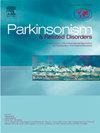Huntington’s disease-like 2 patients’ profile in a Brazilian cohort
IF 3.4
3区 医学
Q2 CLINICAL NEUROLOGY
引用次数: 0
Abstract
Background
Huntington disease-like 2 (HDL2) is an autosomal dominant disorder caused by an abnormal CAG/CTG repeat in exon 2A of junctophilin-3. This is the most common Huntington's Disease phenocopy and is characterized by psychiatric, cognitive, and movement disorders. This study aimed to describe the clinical phenotype of HDL2 patients in Brazil and compare the findings with those in the literature.
Methods
This was a descriptive, observational study with a cross-sectional and retrospective component that evaluated 33 genetically confirmed HDL2 patients. Clinical data were collected using the Unified Huntington's Disease Rating Scale (UHDRS) and additional scales assessing sleep, mood, and cognition.
Results
The sample had a balanced gender distribution and was predominantly comprised of white individuals. Median disease duration was 11 years, median age at diagnosis was 44 years, and CAG repeats were 47. On the non-motor scales, the median scores were 33 points for fatigue, 31 points for apathy, and 18 points for depression. A significant negative correlation was observed between CAG repeat length and age at symptom onset (r = −0.76, p = 0.002). The median diagnosis delay was 4.5 years.
Conclusion
While some findings, such as sex ratio and median CAG repeat length, were consistent with those of previous cohorts, this Brazilian sample exhibited longer diagnostic delays, an older age at assessment, and more severe motor scores. However, due to the small sample size, the results should be interpreted cautiously. Larger studies are needed to confirm these associations.
巴西一群亨廷顿舞蹈病样2例患者的资料
亨廷顿病样2 (HDL2)是一种常染色体显性遗传病,由结蛋白-3外显子2A CAG/CTG重复异常引起。这是最常见的亨廷顿氏病表型,以精神、认知和运动障碍为特征。本研究旨在描述巴西HDL2患者的临床表型,并将研究结果与文献进行比较。方法:这是一项描述性、观察性研究,采用横断面和回顾性的方法,评估了33例基因确诊的HDL2患者。使用统一亨廷顿病评定量表(UHDRS)和评估睡眠、情绪和认知的附加量表收集临床数据。结果样本性别分布均衡,以白人为主。中位病程为11年,诊断时中位年龄为44岁,CAG重复数为47。在非运动量表上,疲劳得分中位数为33分,冷漠得分中位数为31分,抑郁得分中位数为18分。CAG重复长度与症状出现时的年龄呈显著负相关(r = - 0.76, p = 0.002)。中位诊断延迟为4.5年。结论:虽然一些发现,如性别比例和中位CAG重复长度,与先前的队列一致,但巴西样本表现出更长的诊断延迟,评估时年龄更大,运动评分更严重。然而,由于样本量较小,结果应谨慎解释。需要更大规模的研究来证实这些关联。
本文章由计算机程序翻译,如有差异,请以英文原文为准。
求助全文
约1分钟内获得全文
求助全文
来源期刊

Parkinsonism & related disorders
医学-临床神经学
CiteScore
6.20
自引率
4.90%
发文量
292
审稿时长
39 days
期刊介绍:
Parkinsonism & Related Disorders publishes the results of basic and clinical research contributing to the understanding, diagnosis and treatment of all neurodegenerative syndromes in which Parkinsonism, Essential Tremor or related movement disorders may be a feature. Regular features will include: Review Articles, Point of View articles, Full-length Articles, Short Communications, Case Reports and Letter to the Editor.
 求助内容:
求助内容: 应助结果提醒方式:
应助结果提醒方式:


